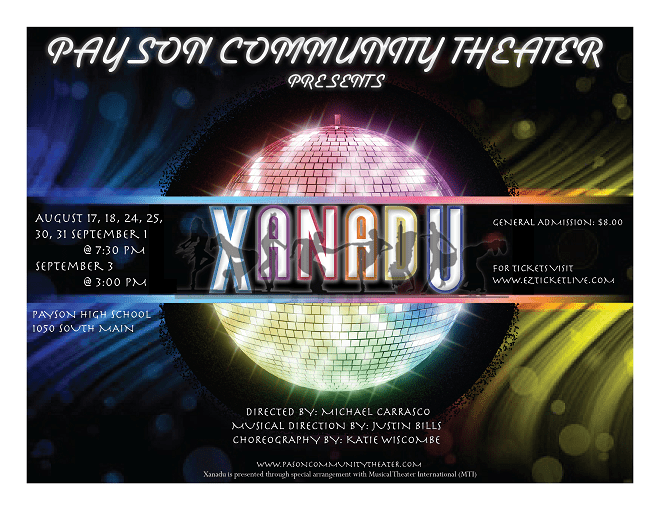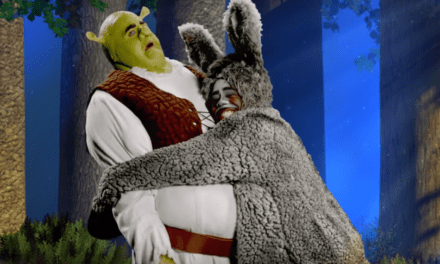PAYSON — Pop quiz! Where can you see a dancing demigods, 1980’s high fashion, and lots and lots of rollerskating? Xanadu, of course, which is a musical playing through Labor Day in Payson. The story, written by Douglas Carter Beane, takes place in 1980 and is about a young artist named Sonny Malone who is inspired by the ancient Greek muses to build a roller disco (because to someone living in that time period, a roller disco is the pinnacle of all the arts). With a pop rock score created by Jeff Lynne and John Farrar, Xanadu is a fluffy musical romp that never takes itself seriously and which has only one purpose—to entertain.
Michael Carrasco served as director of this production, and he makes it a gloriously gaudy show. His direction in Sonny’s opening monologue and “I’m Alive,” introduces the main characters and clearly establishes the tone of this production: in the first minutes I knew that this was going to be a silly play, lacking any subtlety. Throughout the show Carrasco had his actors ham up their lines (appropriate for this show), and helped his actors remove any inhibitions that would have detracted from the mood of Xanadu. Carrasco also made brilliant use of the projections (probably the best I’ve ever seen in an arts council production), which limited the need for lengthy scene changes while still help establishing locations for scenes. Finally, Carrasco created many wonderful visual images (such as a disturbingly hilarious Cupid, and the silhouette of a young Danny during “Whenever You’re Away from Me”) that were highly creative and memorable.
Starring in Xanadu was the delightful Alyssa Claunch, who as the muse Clio disguises herself as an Australian named Kira (with an impeccable Aussie accent) and falls in love with Sonny. Claunch is a stellar roller skater who effortlessly maneuvered across the large stage in songs like “Magic,” “Suddenly,” and the title number. Claunch’s skating prowess helped show off her beautiful flowing costume (created by Kristi Peck, Noelle Peck, and Kim Hammons) and added to the visual appeal of these parts of the show. More importantly, Claunch recognized that Clio is more than just a collection of funny lines. Instead, Claunch delved into her character’s psychology and helped make Clio an interesting character with whom I could sympathize. Claunch also has a lovely singing voice, although her volume seemed to not be as strong in the higher notes in the score.

Alyssa Claunch and B. J. Oldroyd.
Opposite Claunch was B. J. Oldroyd as Sonny Malone. It took me a little bit longer to warm up to Oldroyd’s performance. But once he powerfully belted the song “Don’t Walk Away,” I clearly saw the wisdom of the director’s decision to cast him as Sonny. (His performance in “The Fall” was also noteworthy.) Oldroyd seemed to connect well with his co-star, especially in “Magic,” and I thought that the two had sufficient chemistry to be a believable (if unlikely) couple. However, Oldroyd’s acting performance felt a little flat in some of his scenes in the first act, I don’t think his acting choices made it clear that Sonny is actually a pretty stupid guy.
The supporting cast made an impression on me, and I write this paragraph with a smile on my face. Miranda Duke and Emily McKinney were shamelessly hammy as the conniving Calliope and Melopeme, the two muses who oppose Clio. Both actresses were melodramatic in their line delivery and helped to maintain the silly mood of the entire play. The other muses (Hayden Berg, Emma Ewell, Nicole Lundquist, and Deven Skaggs) were excellent “backup” and added to the zaniness of many of the songs, such as “All Over the World” and “Don’t Walk Away.”
The choreography, created by Katie Wiscombe, for this production was terribly fun to watch, and never seemed repetitive or simplistic (as often happens in amateur productions). Wiscombe used the styles of both traditional musical theatre and the 1980’s (such as in “Evil Woman”) to create a unique dance style that meshed well with the director’s vision. Many of the musical numbers (such as the two finales) had a multitude of movement on stage at once, and I feel that an audience member would need to attend the show multiple times in order to take in all of Wiscombe’s work.
The only major detraction for this show is one that the cast and creative team are almost surely aware of: the sound. The facility’s audio system sounds extremely old and outdated, and much of the sound was muffled and difficult to discern. Some of the microphones were turned on late also, but this problem lessened over the course of the evening. There was also a minor issue of using a scrim during “Whenever You’re Away from Me,” which I felt was unnecessary and made the dancers harder to see. There’s also the normal hiccups that happen in an amateur show. But there were fewer of these than what Utahns usually see in this type of production. Plus, any audience paying just $8 for a play produced by a group with the words “community theater” in its name knows what they’re getting into. So, these minor flubs didn’t bother me.
When I watch musicals, one way I know that the production is working is if I think to myself, “I want to be in a musical.” By this standard, Xanadu is a success. The music is infectious and the dancing got me tapping my toes throughout the show. This was my first time seeing a Payson Community Theater production; I hope it won’t be my last.







